
Browse Service Heroes
Click here to sign up so you can start posting
your service heroes before their stories are lost
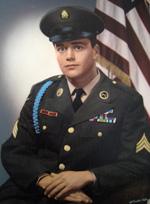
Print My Service Hero
View MyWarBuff Page
Add WarBuff Friend
Share with Friends
|
Recommend Eldon's Story to Digg it | del.icio.us | Reddit
Assigned: 1st Air Calvary, 5th Battalion, 7th Calvary Regiment
Highest Rank: Sergeant (E-5)
Entered Service: 6/19/1969
Exited Service: 6/18/1971
Foreign Service Length: 11 months, 2 days
Continental Service Length: 1 Year, 28 days
Location of Service: Vietnam, Cambodia
Gender: male
Basic Training: Fort Gordon, Georgia
Service Related Injury: Sharpnel in Abdomen
Military Position: Infantry
Place of Separation: Fort Knox, Kentucky
From City: Columbus
From State: Ohio
Current City: Galloway
Current State: Ohio
Date of Birth: 09/1945
|

 |
|
| |
The 7th Calvary was constituted at Fort Riley, Kansas as part of an expansion of the US Army. The 7th Calvary has fought in every major battle (except World War I) since its creation including the Indian Wars, World War II, Korea, Cold War, Vietnam, Persian Gulf and Iraq war where it continues to be active today.
|
| |
General George Armstrong Custer led the 7th Calvary into an ambush during the Battle of Little Bighorn on a Black Hills expedition. The Crow Indian scouts identified a large encampment along the Little Bighorn River so General Custer divided his forces and set out for an all out attack. With just a few hundred men, Custer ran into Sitting Bull’s trap against over 1,800 warriors. The entire 7th Calvary was killed including General Custer where the soldiers were stripped, scalped and mutilated. The Indians who massacred Custer and his troops were retaliating for the white men’s continuous lies, breach of treaties and stealing of their lands.
|
| |
Eldon had finished high school and was working at the time for a boss who did not want to lose Eldon as a valued worker to the draft; therefore, his boss offered him an apprenticeship which gave him a 4-year army draft deferment. As soon as the four years were up, the Army draft board did not forget about Eldon and sent him another notice. Eldon’s family did not openly discuss or take a huge notice to the controversial politics of Vietnam at the time, most likely because Eldon’s father served in World War II and never wanted to talk about his experiences. Eldon’s father was very proud of his son for serving his country. The draft board really liked the Erlenbach family because Eldon’s dad had been drafted in 1944 while his father had two kids working for Curtis Wright making airplanes. Drafting older men with kids who worked on such an important component to the war effort was extremely rare during World War II. Eldon was actually born in New York; while Eldon’s father was overseas serving in World War II, Eldon’s mother and siblings moved back to New York to be with her family for extra support.
|
| |
When Eldon first got to the battalion base, he had really nice clothes with his name personalized and stitched on them and everything. He was surprised when one of the first things they told him to do was to dump out all his clothes and put them in a pile with everyone else’s clothes. He learned really quickly that no soldier had any personal clothes any more; they were given to whoever was lucky or unlucky to need them next. When out on missions, approximately every three days a helicopter would drop off clean clothes and food rations. As soon as the helicopter landed and the doors opened, pretty much every soldier would have to fend for themselves. This is why in many Vietnam photos the soldiers look like a rag tag army but it was just really economics. If a soldier was on guard duty while the supplies came in they could be really unlucky with clothes that were left over when their shift ended and often got uniforms that did not fit at all. All of the personalized names were removed from all of the uniforms before dropping them in the jungle as it was important that no names or ranks were on any of the clothes so that the Viet Cong could not target the officers in the field.
|
| |
During one mission stretch, Eldon and his unit were out for sixty-nine continuous days in the Vietnam jungle. Approximately every three days a helicopter would do a re-supply drop for his unit. Eldon would have to cut out an area for a helicopter to land then pop smoke so the helicopter could find the landing zone. After a fresh supply Eldon would have a good 60 or 70 pounds in his pack. Sometimes they would have to drink the water out of streams making it necessary to have iodine tablets that would help to purify the water as much as possible given the circumstances. Many nights the Fire Base would shoot out a flare where after the platoons on missions could shoot their compass to the flare allowing them to dissect their position which then allowed the Fire Base to send out artillery support directly to them. Another way to call in a strike by a gun ship or a jet was to light off smoke signals, however, the jungle was so dense that many times the smoke would come out of the tree lines at a much different location from where it was let off which caused all kinds of problems.
|
| |
Eldon was living in Columbus, Ohio with his parents when he was ordered to report for draft duty at Fort Hayes in Columbus, Ohio at 7AM on June 19, 1969. While Eldon was waiting in a room with the twenty nine other men who had received the same orders, a guy came in and took eight of the largest and strongest looking men, they were all drafted into the US Marines on the spot; Eldon was a little confused as he didn’t realize that the Marines were drafting at that point. Eldon completed his physical exam and was assigned to the “KP” Kitchen Police duty, he was told to wait around and that he could not leave Fort Hayes. To his surprise, later that same night Eldon was on a plane to Fort Jackson, South Carolina. He thought that after his physical and enlistment that he would have a few days before leaving but he had to get on a plane that same day without knowing where he was headed; the Army probably did not want people to rethink their Army enlistment and dodge the draft. That day Eldon’s mom thought he was just staying out late with the guys but she could not have been so lucky. When he arrived at Fort Jackson, Eldon was only allowed a 30 second phone call to tell him mom, “I am in the Army” and it was that simple. She was pretty awestruck but they did not have time to discuss things any further.
|
| |
After a couple days of processing, Eldon was bused to Fort Gordon, Georgia for basic training. During the eight weeks of basic training, the Army’s main objective was to break every person down and teach them discipline. The main lesson was that everyone was part of a team and if any of the parts would break, the entire team would fail or more dramatically die. Eldon was older than a lot of the men because of his deferment and had a pretty good head on his shoulders being able to see through a lot of the Army’s strategies and team building techniques. Eldon’s physical fitness, maturity and perspective really helped him through the eight weeks and made the experience much easier to endure. Eldon, along with the other privates in his unit during basic, were essentially confined to the base the entire time, even when they earned their liberty passes, basic training soldiers could not have a car and Augusta, Georgia did not offer many amenities in the area, so there really weren’t too many options for their limited time off. During basic training, Eldon was heavily trained on the M-16 exclusively. Eldon said the enhancements with the black powder by 1969 eliminated most of the issues with the M-16 underperforming in combat scenarios. He could not recall a problem with jamming or malfunction during his service even while it was used during very tough jungle operations wet or dry.
|
| |
For the most part, most soldiers stayed inline sometimes people would get an attitude but most of the time there were no problems. Everyone was just trying to stay alive.
|
| |
During his leave Eldon went back to Columbus along with some of the men whom he was drafted and completed basic training alongside. While he was at home his father never sat him down to give him some advice for what he may experience. After a two week leave, Eldon returned to Fort Gordon in Georgia for Advanced Infantry Training for an additional eight more weeks. Eldon would learn weapons, hand to hand combat, how to throw grenades, firing, survival training, and jungle warfare. By this time, Eldon’s training was setup specifically for Vietnam to prepare soldiers for what they were about to experience.
|
| |
Eldon was once again given two weeks of leave before he was about to embark on the real deal that is the Vietnam War. By this time, Eldon had two friends Austin Funk and Al Rader in his unit. All three of them met with their families for a going away gathering in Columbus, Ohio. It was not until all three boys and their families were together that Eldon’s mother was hit with the realization that her son was really going to Vietnam where she would not be able to protect him and he would be fighting for his country in the Vietnam War. Al Rader was killed in action in Vietnam two weeks later.
|
| |
Eldon’s first impression of Vietnam was that it was very hot and humid. The smell of country with the jungle and heat was very different from what than Eldon was used to with the Ohio climate. During this whole time Eldon was just thinking about what might be happening next. His first meal was served out of a very large trough of eggs that were about half cooked and not pleasant, this would set the culinary stage for Eldon’s entire tour. Eldon did receive some exposure to the native Vietnam culture on his bus ride around Saigon from Bien Hoa to Long Binh.
|
| |
At the 90th Depot Battalion in Long Binh, Eldon was assigned to the 7th Calvary; however, before he could join the unit, he had to go through rigorous training during which every unit had their own flavor. Eldon was quite shocked when he had to climb up a tower using only a rope and then jump off backwards to repel down. Eldon was officially assigned to the 1st Calvary Division, 5th Battalion, 7th Calvary regiment, Bravo Company, 2nd Platoon. As soon as Eldon reached his unit, he was informed that the 7th Calvary Regiment had been General George Armstrong Custer’s Unit to which Eldon thought “oh great” in recalling the legacy and fate of Custer and his troops at Little Big Horn.
|
| |
Eldon adapted very well to his unit; he knew that he was in Vietnam to learn and did not have any other options as if he didn’t pay close attention to the soldiers that were already there he could be killed or get his friends killed. The Sergeants told him to forget everything he learned in the states and told him exactly what he needed to know to survive in Vietnam.
|
| |
Eldon was ordered to report to Oakland Army Terminal in California. Eldon arrived a day early and was excited to see San Francisco for the first time. He wanted to visit Alcatraz and Fisherman’s Warf, while he was exploring the town, he internalize the reality that 1969 California was not a good place for servicemen. He did not even have on a uniform; the locals though could spot them without any trouble as the army crew cuts definitely gave them all away. He was amazed that him and his buddies even made it out alive but he did get to see the sites. Eldon was apprehensive at first as the reality of deployment loomed overhead but later the anticipation got to him and he really wanted to see where his journey would take him and was ready to embrace his duty in fighting for his country. In Oakland, California, Eldon was given his jungle attire and left Travis Air Force base on Seaboard World Airlines for Ton Sanut near Saigon, Vietnam after a short stop in Hawaii. Eldon and all other US Army soldiers reported to the 90th Depot Battalion in Vietnam where they were assigned to their new unit.
|
| |
After the somewhat basic and short training, Eldon essentially started missions right away. Eldon said that no one really kept track of missions as it was pretty much a daily duty. Missions in the beginning would start out of Phuoc Vinh and were typically night missions. Each night before sunset they would go out in a duce and a half truck, when it got dark they would move near their position on the river so that enemy could not see where they were going or the locals for that matter. They would then go out and setup claymore mines, trip flares and other boobie traps along the river, knowing that the VietCong used the river as a highway. When a claymore mine was hit or a flare went off it would light up the entire area and Eldon’s team would take out the enemy. At daybreak, they would take down all the mines and start the routine over again the next day.
|
| |
Eldon shot the M-16, M-60 and M-79 during the Vietnam War. Most frequently, he would typically carry the M-16. At times, a point person may carry a shot gun while in the bush. Typically, thick and stocky men would carry the M-60 along with two ammo bearers and an extra barrel. Ammo bearers would often carry a can of ammo for the M-60 and also the ammo around the neck which allowed for easy access as an M-60 had an extremely high rate of fire requiring a massive amount of ammo.
|
| |
Every night Eldon would always have two hours of guard duty while on a mission. The harsh weather, rains, monsoons, and the heat would take a toll on the soldiers to the point of exhaustion, not to mention the mental burdens of war. Eldon typically just slept on the ground, they never dug fox holes, as were frequent in WWII, because they were always on the go. At night, they would always setup a perimeter to ambush the enemy if necessary, so they would feel fairly safe at night while everyone was sleeping with their rifles.
|
| |
Tay Ninh where Eldon was based was much closer to the Cambodian border and a lot more action was going on. Cambodia was considered a safe zone because the United States did not cross the border providing a safe harbor for enemy combatants. The Viet Cong could attack in Vietnam then retreat to resupply on the Cambodia side without any fear of a counter attack.
|
| |
After a coup in Cambodia by a US supported government, the US was offered a window of time to invade part of Cambodia to take apart the North Vietnamese Army (NVA) and Viet Cong’s (VC) supply chain. Originally, Nixon wanted the neutral Cambodia to become an ally which is the main reason why the US did not attack. However, with the pro-western government in place for a short time, the US took it opportunity to wipe out as many enemies as it could.
|
| |
The Vietnam War was the first time in American history where actual footage was allowed to be broadcast to the Americans on their home televisions, so instead of letters or hearsay, the American people were able to watch what was really happening on the front lines. Norman Lloyd was a combat cameraman with CBS assigned to the Bravo Company to document the war to send back to the nightly news with Walter Cronkite. Cambodia was Norman Lloyd’s first assignment. Norman was born in Australia and quickly became one of the guys. He had a long hair and many soldiers thought he was crazy because he made a choice to be there while everyone else was drafted. Norman Lloyd left Sydney, Australia from an impoverished family and hard working job with a fatalistic attitude that he was not coming back so he just tried to last as long as he could to get the job done. He would film standing up and really put himself in harms way. Eldon has continued his relationship with Norman and they remain good friends. Eldon was featured in Lloyd’s movie, Shakey’s Hill, a documentary of Norman’s first combat assignment.
Eldon did not realize that the footage was being shown on primetime news and a lot of the men in his company were perplexed when they received letters from friends and family members saying that they saw them on TV. Here Eldon was sending letters to his family telling them that “nothing much was really going on” to try not to worry his parents with situations out of their control, while once Norman’s footage was broadcast, they could see that information was not entirely true.
|
| |
When Eldon would go out on missions, they would always stay within range of their Fire Base which could offer air support coordination, orders, and artillery. Eldon’s platoon would use radios (Prick 25) to communicate with commanders and other troops, they could call in close air support, and coordinate evacuations as necessary.
|
| |
A squad usually consisted of four to seven guys while a platoon was made up of approximately thirty men. Typically, Eldon’s missions consisted of him working with his squad within his platoon. Some operations would require the manpower of the entire company which enlisted a approximately 120 soldiers. One strategy employed when on missions was to stay off the trails because they would often be ambush sites, however this decision had to be balanced by the fact that sometimes going through the jungle could make a lot of noise. Soldiers would try to stay about ten to fifteen feet apart. Eldon’s senses were enhanced during his tour as he was always looking for something out of that might be out of place and waiting for or anticipating the unexpected. There were a lot of snakes, ants, and leaches. Despite their high numbers in the jungle, most of the time they were more of an annoyance than a threat. Jungle rot on the foot was a common problem because of the wet jungle and never being able to keep one’s feet dry. Even today Eldon still experiences some problems with his feet. He also got diabetes from the Agent Orange being sprayed by the Americans in the jungle as an herbicide throughout Vietnam War to destroy the plant-based ecosystem and disrupting the Vietnamese food supply.
|
| |
The 124 man strong Bravo Company entered Cambodia on an eight week campaign. The area they occupied was known as a free fire zone which meant that anything that moved was going to be fired upon without warning so no villagers would stay around. Eldon knew something big was going on because they took off with 40 helicopters out of Bu Dob for about a 40 minute flight. Each helicopter had a pilot, co-pilot, two side gunners and a squad (four or five men). Typically, Bravo Company worked with about six choppers in a raid, so Eldon knew that some serious action was awaiting them. The cobra gunships, jets, and Huey’s would light up the perimeter to clear a way for the soldiers to get on the ground. Once the soldier’s hit land, they would all run for cover then once the choppers left it would be dead silence and that is when it would hit you that this is war and people are coming after you. The platoon sergeants were briefed ahead of time and everything was very organized during assaults even though Eldon never had advanced information. The 7th Calvary started seeing action very quickly which became their normal at first but quickly escalated as the unit started to get close to the main supplies. The strategy by Battalion Commander Maury Edmonds at the time was to seek out the enemy and continue in the direction were the fighting was the most intense.
The 1st Air Cavalry division entered what came to be known as "The City", southwest of Snoul. The two-square mile People's Army of Vietnam (PAVN) complex contained a massive amount of military material. To the northeast, other Air Cavalry elements discovered a larger base on May 6 called "Rock Island East" after the U.S. Army's Rock Island Arsenal in Illinois; the area contained an even larger arsenal than the first one.
|
| |
Eldon’s platoon was assigned point which the three platoons would rotate from day to day between the front, middle, and rear. Eldon’s squad was at the point of platoon. They were hit pretty hard so they pulled back a little bit to regroup. Later that evening, everything just left loose and Eldon was hit by shrapnel in his abdomen earning him a purple heart, while he does not remember much after the initial hit. Eldon stayed overnight and was flown by helicopter medical evacuation the next day. Eldon learned about what happened to him at a unit reunion as he did not remember much about the incident or staying the night. The day began with twenty-seven men in his platoon and tragically by then end of the day only twelve were left. After about four days of recuperation in Tay Ninh, Eldon returned to Cambodia. The events leading up to and at the top of Hill 423 (Shakey’s Hill) were the toughest fighting battles of Eldon’s tour.
|
| |
While Eldon was on patrol northeast of Rock Island East, a point man Chris A. Kefalos, nicknamed “Shakey”, from the 7th Cavalry Regiment, tripped over a metal plate buried just below the surface of the ground. Shakey was the first man to reach the summit of the hill but was also the first to be killed. The cache Shakey had uncovered was the first of 59 buried storage bunkers at the site of what was thereafter known as "Shakey's Hill." The bunkers contained hundreds of tons of cases of weapons and ammunition, some of which were turned over to the Cambodian army. It was to be the largest cache found of the entire Vietnam war. Of the one hundred twenty four men only fifty two made it to the top of Hill 423. Shakey was an 18 year old young looking man who was a very nervous person but quickly became part of the group. Shakey’s bravery on the day he was killed led to his fellow soldier’s honoring him by renaming Hill 423 as Shakey’s Hill. The name of the hill meant so much more than just a piece of land, it represented that Bravo company had made a real difference to save American lives in a war many Americans unfortunately did not support.
The weapons were sent back to the company area and each soldier was given a rifle or pistol. Due to the fact that Eldon had earned a purple heart, he was allowed to get a brand new Russian sniper rifle which he has on display at a local Military Museum.
|
| |
One of the sad truths is that so many died throughout the Cambodian campaign including many officers, so very few soldiers were actually given awards for their heroism battle strategy as the officers are the only ones to report their men for recognition.
|
| |
Eldon describes the bond between himself and fellow soldiers as something you cannot explain. Even after not seeing his buddies for decades, when he meets up with them at reunions, it is like he has known them his entire life and no time has passed since their last encounter. Eldon describes the reunions as powerful healing process for everyone, both the soldiers, their wives, and families.
|
| |
After an eight week tour in Cambodia, the US pulled out and Eldon went back to Tay Ninh where the action was greatly reduced. Eldon never received a liberty pass for some R&R but he did get a three day break after all of the missions in Cambodia. While his break was officially three days, he was still inside an air base perimeter so it took one day to process and get off the base to any new destination, one full day relaxing, and then the last day was spent getting back to the base and checked in; it may not have been three full days but even one day to take a deep breath was a huge welcome relief.
|
| |
Eldon carried a little black bible with him and a rosary around his neck to keep him safe and give him comfort.
|
| |
Everyone received a seven day R&R pass for their tour and each person could take it whenever they wanted. Eldon elected to wait until the end to take it so that he had something to look forward to during the missions. Eldon went to Hong Kong which was an exciting adventure and cultural awakening;, but it just wasn’t the right time.
|
| |
When Eldon came off the front lines to the rear they had an early-out program which allowed soldiers to take another R&R where he was approved to go to Australia but he decided he would rather get home sooner because he was tired and really did not have much money, looking back he wishes he would have gone but at the time getting home was a bigger prize. By this time, Nixon was facing a great deal of pressure from multiple groups to end the Vietnam War, so as a result, troop levels were slowly decreased during this period. Eldon wondered why he was getting an early-out while many of the men he joined up with were still on the front lines, so he asked a Sergeant in the rear what was going on. The Sergeant said that his buddies’ orders were down in Long Binh so they could not get out; Eldon said that was not right because if one of them got hurt and their paperwork was just sitting a few miles away, it would not be right and his conscious couldn’t let it go. The Sergeant said that someone would have to go down to Long Binh; Eldon quickly volunteered himself for the mission. Sure enough, as soon as the orders were received back to Battalion headquarters, all kinds of men were coming home. All of this was due to Eldon’s heroism and looking out for his fellow brothers in arms.
|
| |
When going through his discharge paperwork and out-processing by an officer at Fort Knox, Eldon had the opportunity to re-enlist but the man just looked at him and said sign here. Some of soldier’s re-enlisted but very few of the men on the front lines.
|
| |
After serving in Vietnam, Eldon returned to the same job he had before the war, but realized that life would never be the same and no one here could ever truly know what it was like in Vietnam. He knew things would be different while he assimilated back into civilian life, while he never anticipated the reactions by community members or how much people really expected him to resume life just where he left it, Eldon said that it was really rough. The people just did not get it and had really no appreciation for his service or what was really going on. Eldon would not even waste his time talking to those people because you never knew what they were going to say. Contrary to popular belief that only the “dumb” people went into the Army, all of the men in Eldon’s unit were high school graduates, many college graduates along with many of the leaders from West Point. Eldon pointed out that his Calvary Regiment never lost a battle while he was in and he did not personally understand many of the political motivations like most people of the United States’ strategy in Vietnam.
|
| |
Eldon never noticed it himself but people around him told him that he, like many of the Vietnam veterans, had the “thousand foot stare”, Eldon remarked that war does strange things to people and often memories would hit you where you least expected them to regardless of your surroundings. He had quite a few people just instantly know that he had served just because of the way he would look off into the distance and be almost lost in his memories. Eldon has a picture of him at the supper table with his family where the “thousand foot stare” is evident and rather eerie as Eldon reminisced.
|
| |
When Eldon came back, he went to the VA a couple of times and it was pretty bad but he said now the VA is fantastic.
|
| |
Eldon flew out of Ton Sanout, Vietnam through Japan, Seattle, McGuire AFB, New Jersey. When flying over the Pacific, one of the radars went out on the plane so they had to turn around because they had not reached the mandated half way point; consequently, Eldon’s trip took a great deal longer for a total of thirty six hours. At Fort, Dixon he received his new orders and a new uniform and was given a two week leave to return home. After his leave, Eldon had to report to Fort Knox, Kentucky for his final service. Eldon’s father never took off work for anything but he was sure to be there when Eldon arrived in Columbus, Ohio that Monday morning which meant the world to Eldon to see him there for him.
|
| |
Eldon drew a number of parallel comparisons between the Iraq War today and the Vietnam War. The jungle warfare and urban combat are very similar. One could be buying beer from a villager during the day and at night they could be your worst enemy. With modern warfare, now there is really no front line and it gets really difficult and tricky to know who you are even fighting on any given day. Eldon said the unknown really wears on a soldier whereas a traditional battleground would result in a different kind of wear on a soldier.
|
| |
Smitty (Dayton)
Chambleos (Dayton)
Kentucky
Gabby
Brian Larsen (Minnesota)
Dan
Michael Albert Wainwright (Illinois)
Jack, Squad Leader
Robert Wayne Coons (New York)
Frank Thurston (Fort Wayne, Indiana)
Jim Eakes
Gary David Sengstock (Wisconsin)
Lefty (Illinois)
Hector
John McInnes (Mac)
Roy Martin
William Rowley
Joseph Torres
Bill Wingate
Alan Reed Rader (Fostoria, Ohio)
Darrel Edward Burns (Washington)
Gerald Douglas Tomlinson (Michigan)
Ronald Douglas Schulz (Kansas)
Barry Thomas Mullineaux (Pennsylvania)
Joseph Sebastian Sanchez (Texas)
Michael Lewis
Bill Moore
Norman Lloyd
Wade Lemons
Evan W
Fred Kremer
Mac Coffman
|
|
|
|
- Air Medal
- Army Commendation Medal (with Valor)
- Bronze Star Medal
- Combat Infantry Badge
- National Defense Service Medal
- Purple Heart Medal
- Republic of Vietnam (RVN) Campaign Medal (with 60 Device)
- Vietnam Service Medal
|
|
|
|
Click on the pictures to enlarge.
 |
|
|
|
| |
Left Jack, Mike, Eldon, and Dan in Vietnam.
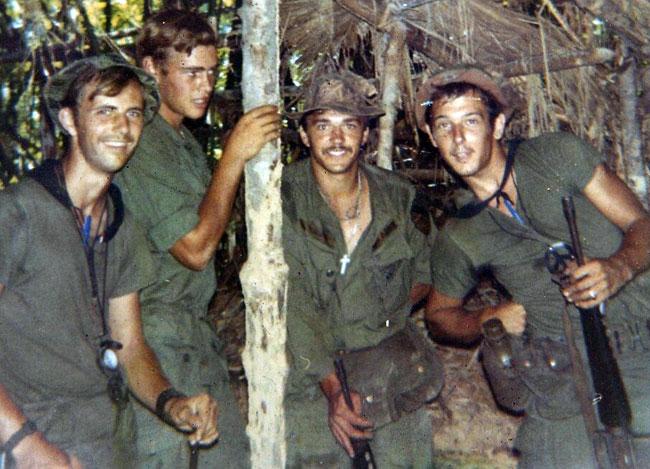
|
Left Dan and Eldon. Eldon wore his rosary in Vietnam and Cambodia.
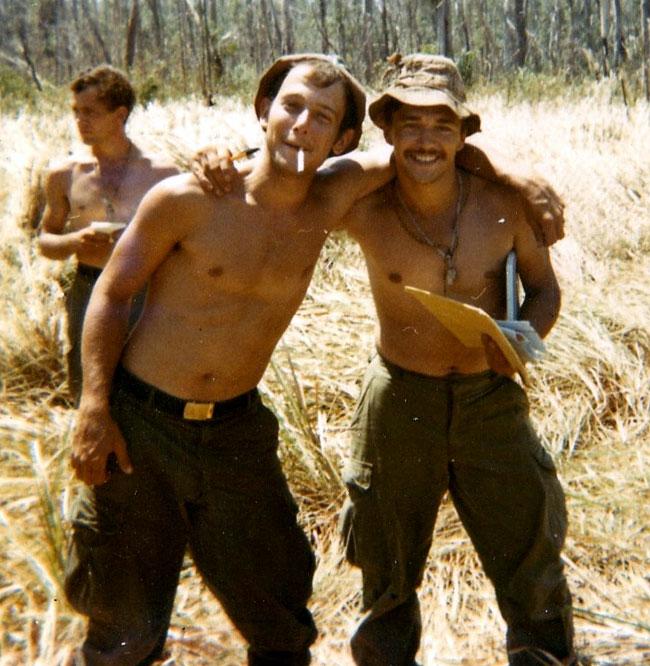
|
Left Brian, Mike, Bob, and Frank in Vietnam.

|
| |
Phuoc Vinh Vietnamese market and village 1970
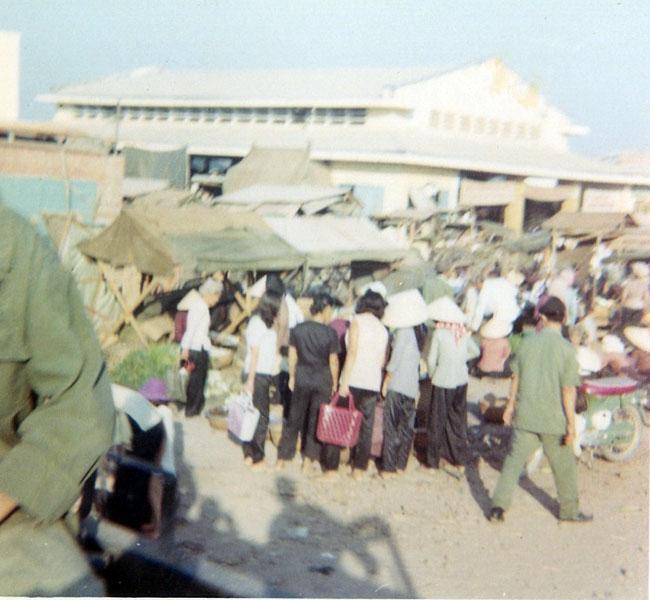
|
Left Frank, Mike and Eldon in Cambodia 1970.
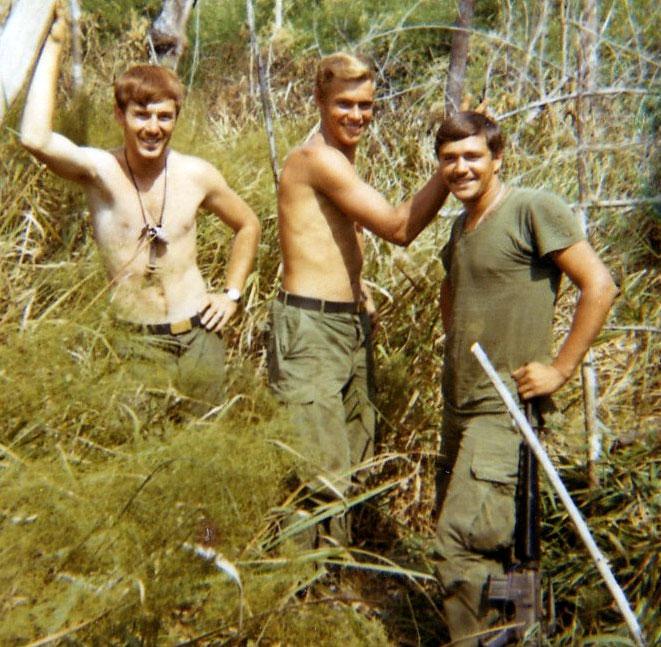
|
Left Gary Sengstock (KIA) and Frank Thurston in Vietnam 1970.
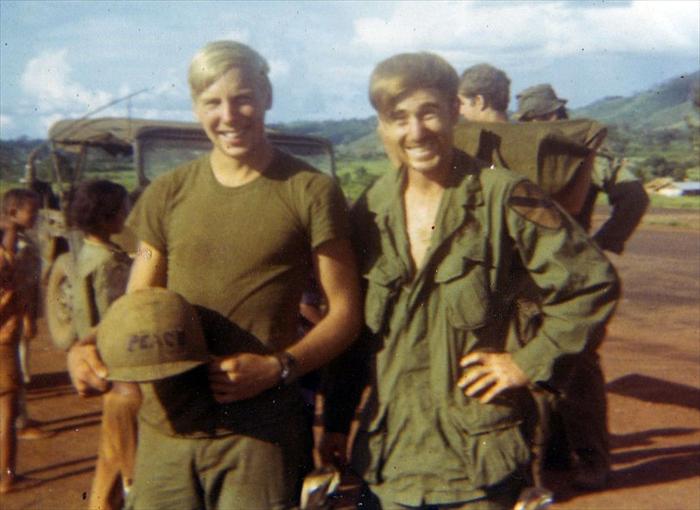
|
| |
Left Roy and Eldon right in Vietnam.
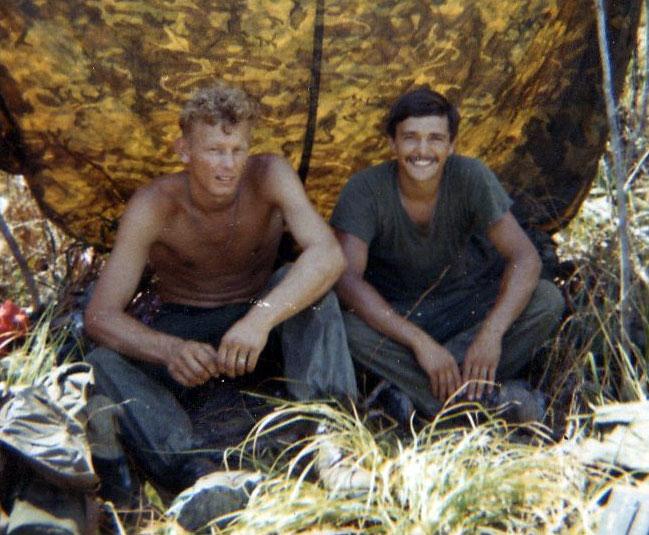
|
Left Mike, Eldon, and Dan.
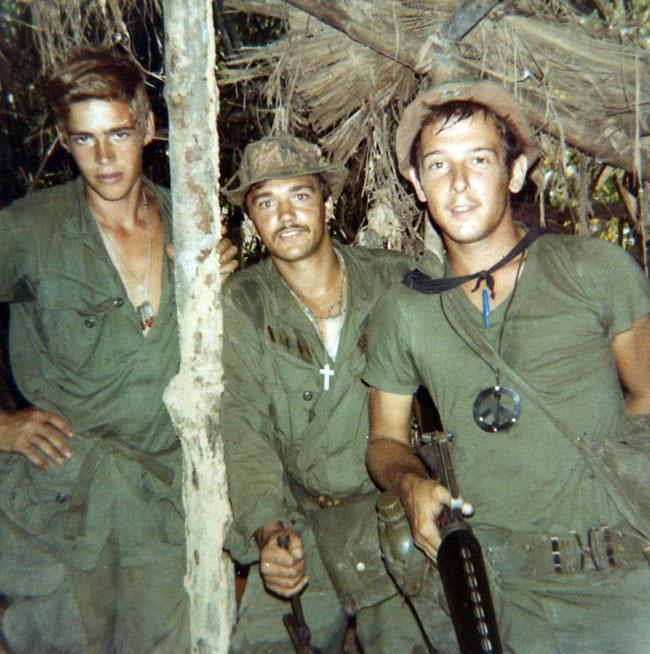
|
Eldon's platoon in Cambodia.

|
| |
Eldon (3rd left) and Mac Coffman (2nd left) at the Vietnam wall.
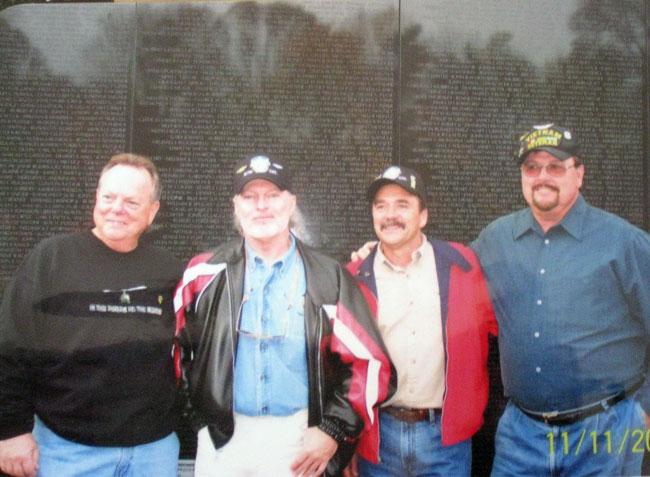
|
Lefty (Illinois), Smitty (Dayton, Ohio), Kentucky (Kentucky), Chambless (Dayton, Ohio.
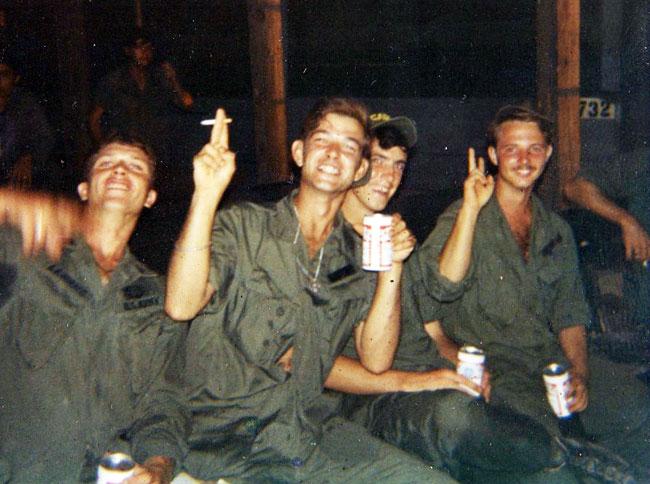
|
Left Punkin, Sly and Jim. Vietnam 1970.
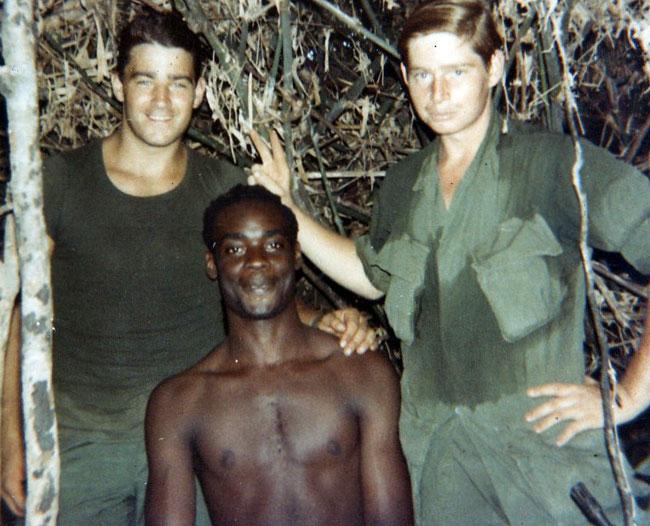
|
| |
Phouc Vinh Vietnamese Compound.

|
Clearing an "LZ" landing zone for helicopters to land sometimes lead to fires. Frank and Sly.

|
At a 3-day stand down with local Vietnamese singing american music.

|
| |
Chopper taking off in Vietnam.
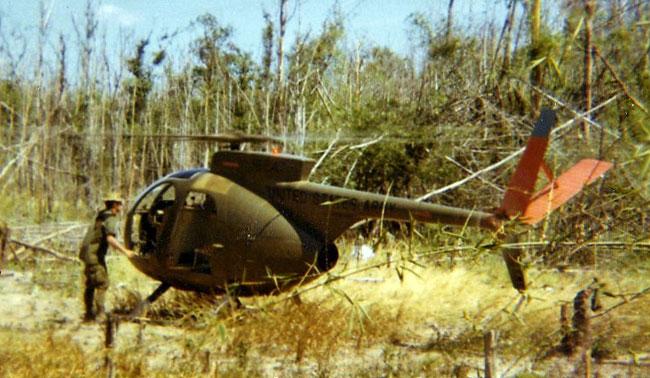
|
Clothes were sent out to the field so this soldier had to use some local attire in Vietnam.
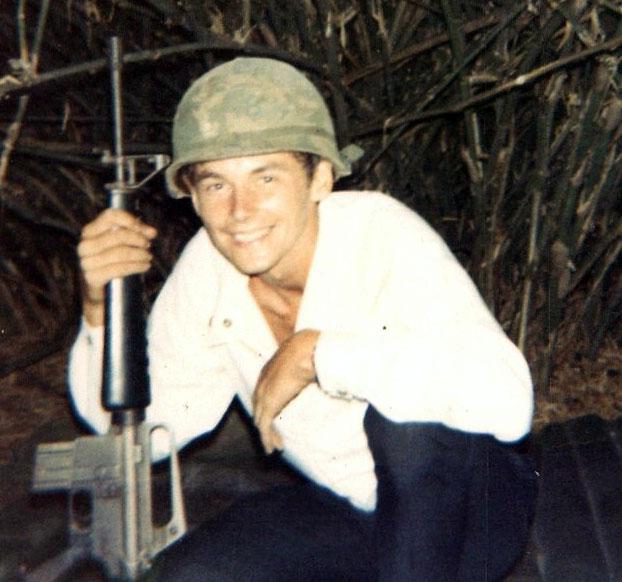
|
M-60 gunner in a Huery Vietnam.
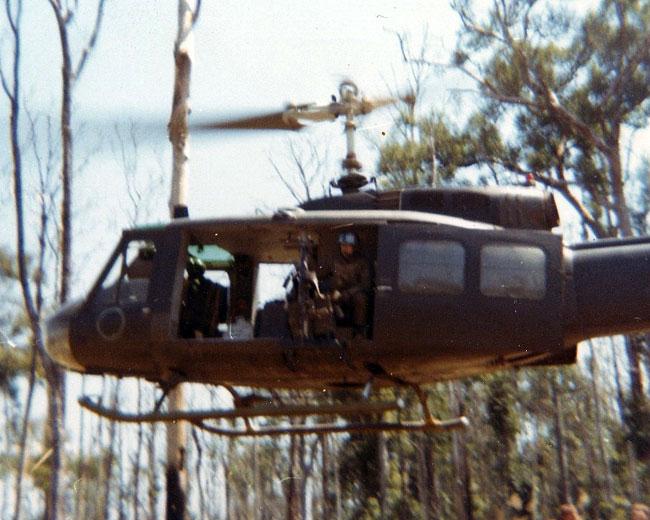
|
| |
Bell UH-1 series Iroquois in Vietnam.
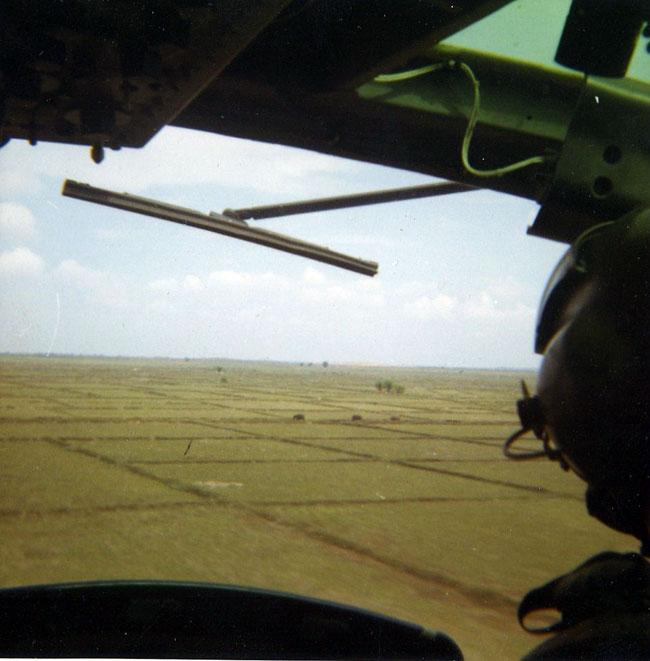
|
Vietnam.
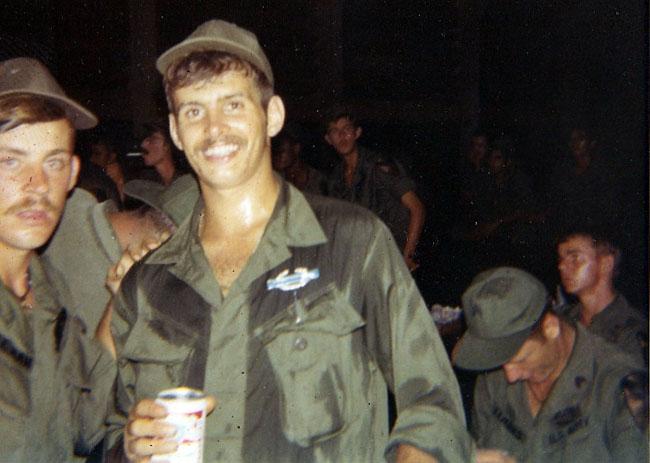
|
Fire base Neil in Cambodia. Artillery shell hit.
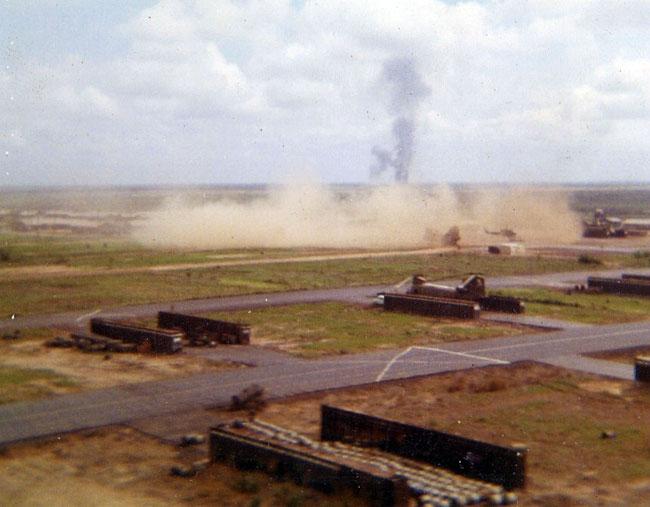
|
| |
Fire Base Wood in Vietnam. Jeep and tank.

|
Dave, Eldon, and Frank.

|
Saigon River in Vietnam.

|
| |
Brian Larsen (Minnesota), M-16, and Eldon.

|
Choppers landing in Vietnam.
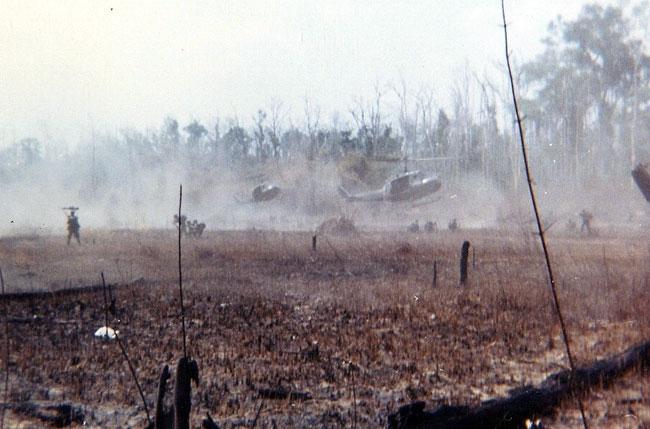
|
Tree tops in Vietnam from helicopter.
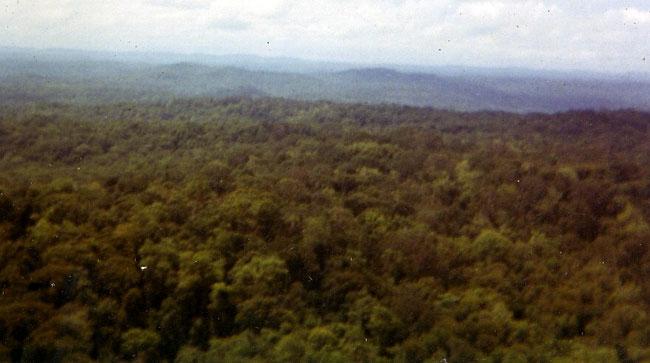
|
| |
Army Commendation Medal.
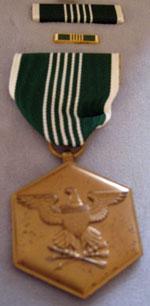
|
Huey pilot in Vietnam.
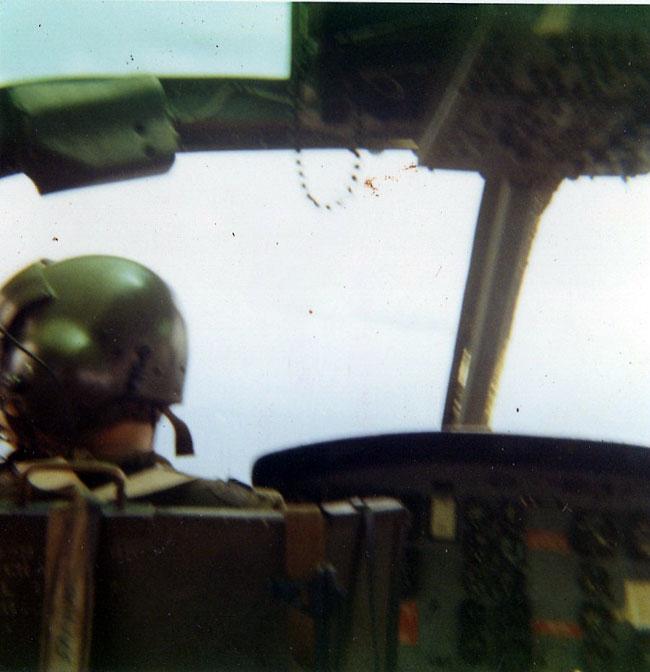
|
Budweiser in Vietnam. Smitty, Hector, Jim Eakes.
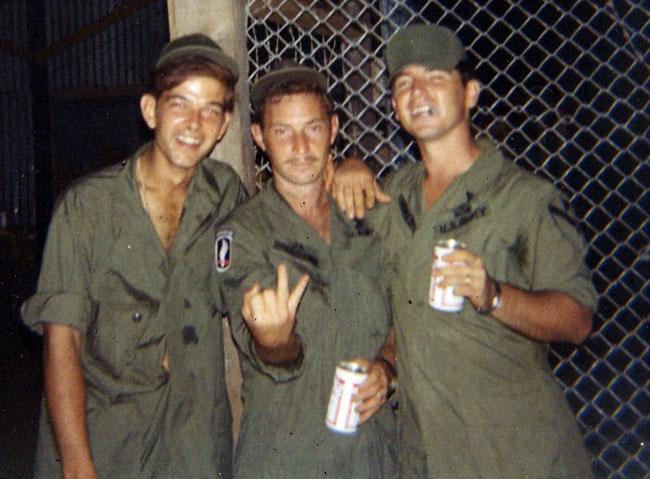
|
| |
Eldon at home shortly after being discharged from Vietnam. This is the 1000 foot stare picture that was a tell tale sign that a person served in the war. Eldon did not realize it was that obvious that people could tell so easily that he was in Vietnam.

|
Vietnamese locals "Mountainards" using elephants to haul supplies.
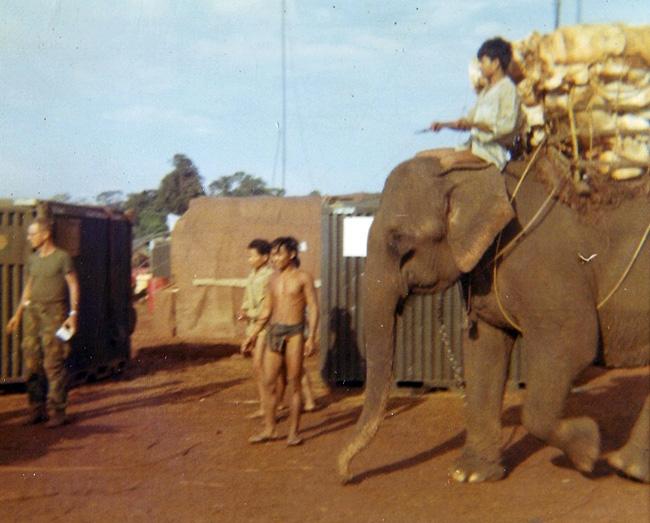
|
Combat air patrol of Huey's.
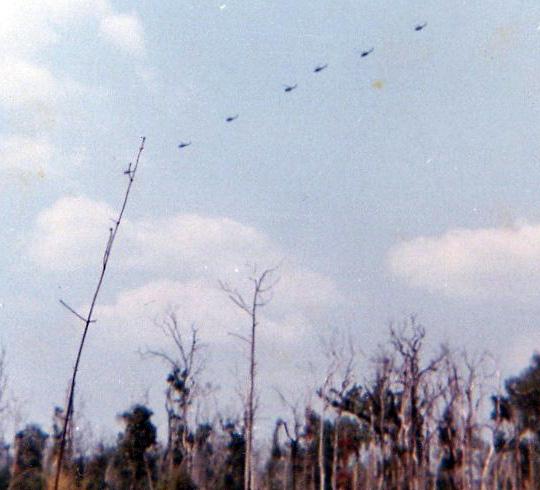
|
| |
Bronze star.
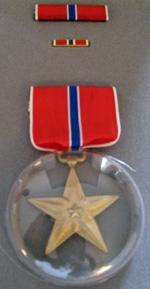
|
Air medal.
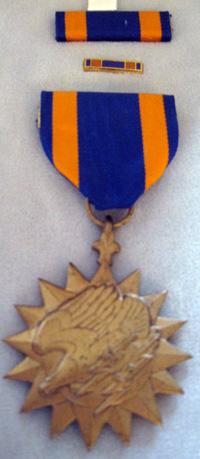
|
Eldon resting with his M-16 in Vietnam.
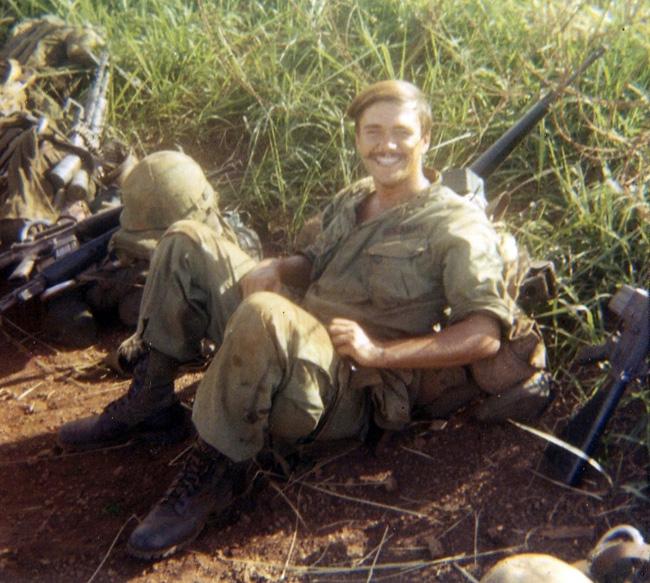
|
| |
Huey picking up soldiers in Vietnam.
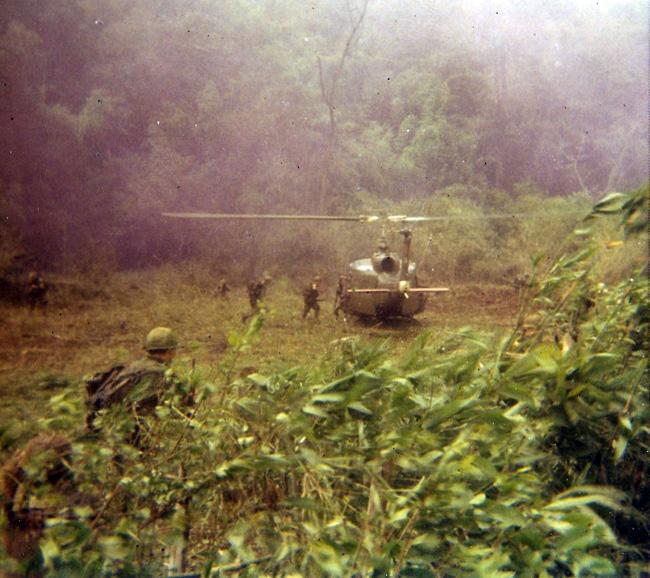
|
Drinking some triple X beer purchased from a local in Vietnam.
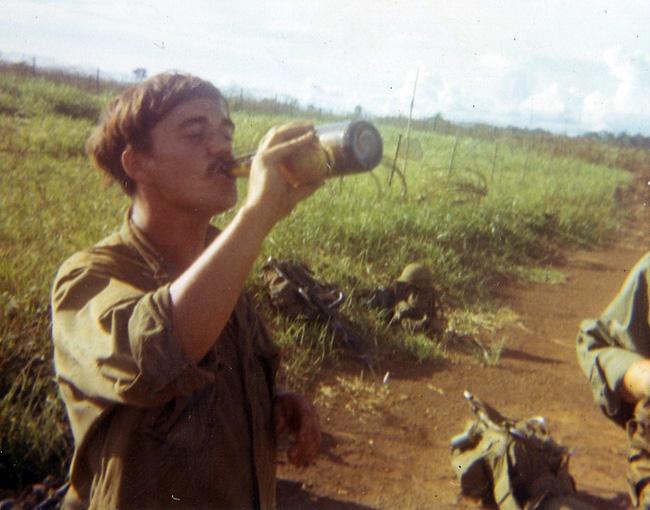
|
Russian sniper rifle Eldon (right) received for being awarded a purple heart. The rifle was captured during the Cambodian raid.

|
| |
Weapons captured from the 1970 Cambodian raid.
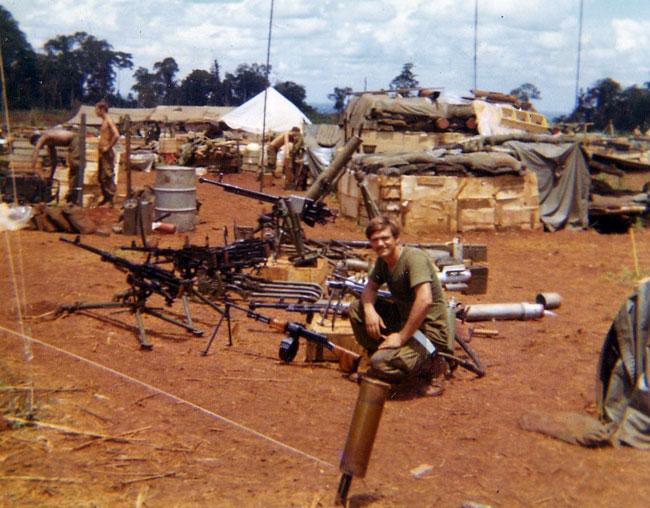
|
C-130 Transport plane in Vietnam.
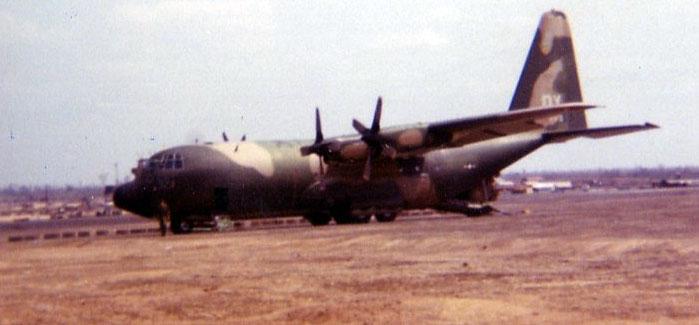
|
Eldon standing in front of a Cobra Corsair helicopter in Vietnam.
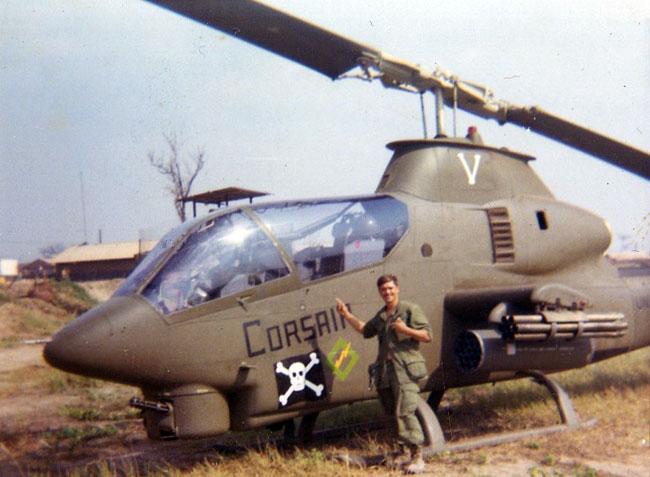
|
| |
Huey landing in Vietnam to drop off soldiers and supplies.
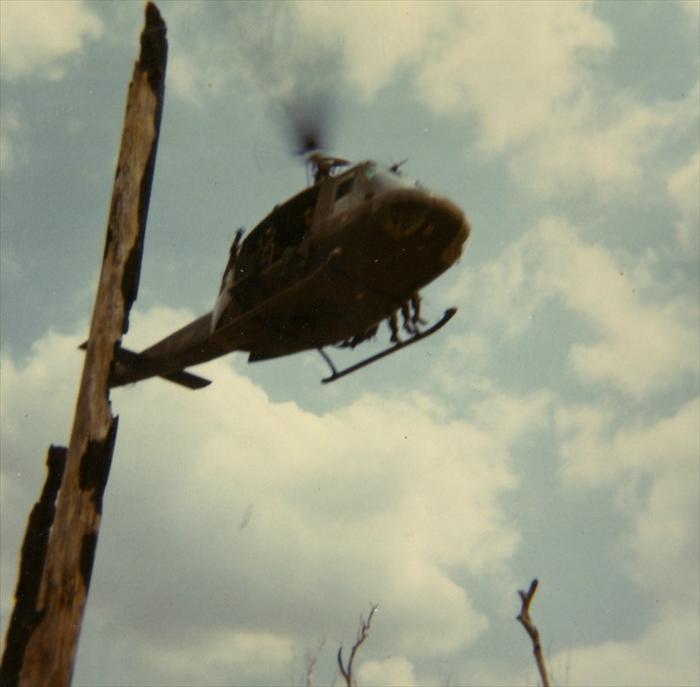
|
Eldon with his M-16 and PRC-25 Radio. The "prick" was developed in the 1950's. Normal range was of 5 kilometers with the short antenna, up to 8 kilometers long antenna and was powered by a battery that could last about 20 hours.
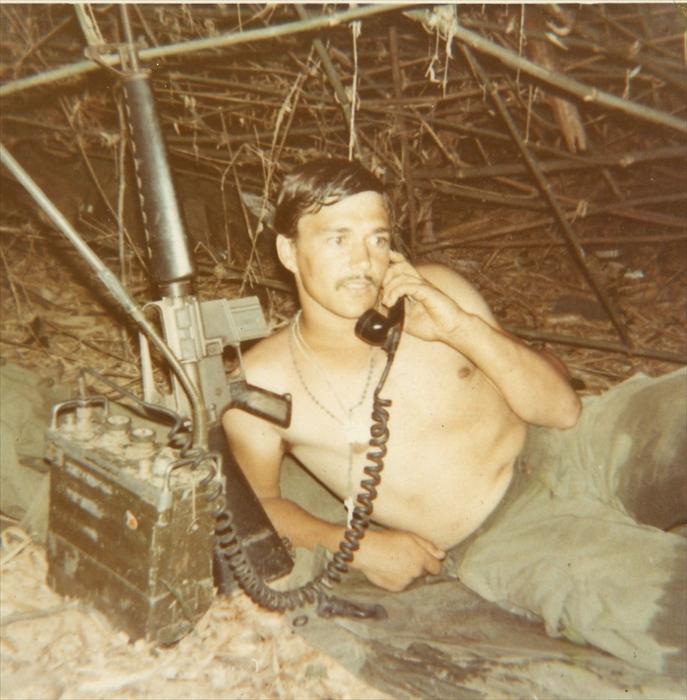
|
On 5/20/1970 in Cambodia, Eldon was awarded the Purple Heart for being hit in the abdomen by shrapnel.

|
|
|
|
|
Click play button near the bottom left of image to watch the video.
|
|

Copyright © 2008-2013 MyWarHistory.com, ltd. All rights reserved worldwide. May not be copied or distributed without prior written permission from MyWarHistory.com, ltd.
|